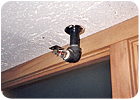
The very threat of fire is a community alert seldom discussed. The first fire sprinkler system known to any community was patented in 1872, and was, in concept, developed for property protection. The earliest buildings blessed with fire protection systems were textile mills in New England.
Fire sprinkler systems were not considered life-safety equipment until the 1940s, and even then, were not mandated by building code to be included in schools, residences, hospitals, hotels or other places of public assembly. The first battery-operated smoke detector for homes wasn’t patented until 1969.
Today, 82% of fire fatalities nationwide are comprised of people who die in their own homes. In 2005, 74% of residential fire fatalities occurred in homes with no working smoke alarms. That year, U.S. fire departments responded to 381,000 home structure fires, in which more than 3,000 people perished. These somber statistics, however, are not the end of the story.
What doesn’t make the news, for some reason, are instances where lives are spared, injuries do not occur and property damage is minimal. And if reported, the existence of a fire sprinkler system barely makes it into the storyline. To compensate for this glaring oversight, we offer the following news items.

Retrofit
fire sprinkler system installations can be a painless and unobtrusive way to
reduce insurance premiums.
October to December 2006
Mt. Prospect, IL:Fire broke out in the garage of a single-family dwelling, the result of spontaneous combustion of soiled materials. A single fire sprinkler had extinguished the blaze by the time firefighters arrived. Fire Marshal Paul Valentine remarked that “there was no fire loss, because of the building’s automatic sprinkler system.” Since 2003, Mt. Prospect has required that all new homes be equipped with a sprinkler system.Park Forest, IL:One activating fire sprinkler contained an oven fire at the Victory Independent Living Center, allowing a wheelchair-bound resident to successfully evacuate. Only the range hood and kitchen cabinets were damaged. Fire Chief Robert Wilcox noted that “in the absence of the sprinkler system, the outcome could have been significantly different, as this property is four stories in height and has 90 units for senior living, many of whom have limited mobility.”
Fulton County, GA:An alarm just after midnight alerted firefighters to an arson fire near the entrance lobby of a high school. Three automatic sprinklers were flowing by the time of their arrival. Firemen quickly doused the small remaining fire.
Las Vegas, NV:Firemen arriving at a 10th floor condominium fire found that one fire sprinkler on an outside balcony at Soho Lofts had completely put out burning wicker furniture. The activating sprinkler had prevented fire from extending to the building interior, averting disastrous circumstances for the 16-story high-rise structure.
Pottstown, PA:A two-alarm fire that started at 3 p.m. in a second-floor clothing store at the crowded Willow Grove Mall was contained by activating fire sprinklers. Thousands of holiday shoppers were evacuated due to heavy smoke coming from a dressing room that filled the store, but officials reported that “a sprinkler system doused the fire.”
Richmond, VA:Cause and Origin investigators determined that a small fan appliance in a 50-resident senior board and care facility caused a fire that was successfully contained by fire sprinklers. Lt. Keith Vida said that “the sprinklers definitely made a difference, because it could have been a whole lot worse.”
Pleasantview, IL:A single fire sprinkler doused flames in the second floor of the Executive Plaza office complex from a fire caused by a faulty portable air conditioner. Fire Inspector Joseph Lyons estimated that hundreds of thousands of dollars were saved by the activating sprinkler.
York, PA:Firefighters arrived at a 94-unit high-rise complex to find a man trapped in his bathroom following a 9 p.m. mattress fire. York City Deputy Chief Steven Buffington said “that occupant’s life was saved by the sprinkler system. Had there not been a sprinkler system installed in that building, he would have been a statistic.” The structure was built before the city required sprinklers to be installed in high-rise buildings, but the housing authority voluntarily had the sprinkler system installed in the spring of 2006.
Fort Collins, CO:An unattended candle was blamed for a 9 p.m. fire at The Preserve at the Fort apartment building. The candle had started a fire on a bathroom shelf and adjacent shower curtain, but two fire sprinklers in the apartment discharged enough water to halt the spread of fire. Jason Mantas of the Poudre Fire Authority said, “Luckily, the apartment complex is sprinklered. Sprinklers in the apartment kicked on, limiting damage primarily to one unit.”

Recorded
fire statistics have shown that the installation of fire sprinklers will
virtually eliminate fire fatalities and reduce injuries and property damage by
at least 80%
January to March 2007
Madison, WI:An explosion and fire at the Palace Latin Club was limited to a second floor bar and dance area by the building’s fire sprinkler system. The cause of the fire has since been determined to be arsonist activity. Nightclub owner Steve Murphy commented that “it would have been a major disaster without the sprinkler system.”Winnetka, IL:A conservative estimate of $750,000 in damages was spared by operating sprinklers at New Trier East High School. A short-circuit of the main electrical service panel was the culprit. According to Deputy Chief Steve Laureys, “The sprinkler system did its job. Three heads contained and extinguished the fire.”
Las Vegas, NV:An 8 p.m. automatic alarm alerted firemen to a second floor fire in a three-story Hampton Inn. Smoke led them to a room in which one sprinkler had already extinguished burning material inside. The fire, termed accidental, could have easily proved fatal in the 127-room hotel.
Maryland:A fire occurring in a multi-story retail shopping mall was limited to its store of origin. Firefighters responding to the 6 p.m. alarm found heavy smoke but soon determined that three automatic sprinklers had done their job. Only small smoldering flames remained in an aisle filled with stuffed animals and paper products. A portable fire extinguisher was used to snuff out what remained of a fire that could have quickly spread.
Columbia, MO:A short from a vent fan started an 8 p.m. fire at the Paternity Testing Corp. building, and was soon kept in check by the building’s sprinkler system. Amidst smoke, responding firefighters found only the last vestiges of fire. The fire began in a storage room that had no smoke detector.
Addison, TX:A single sprinkler extinguished a mid-morning fire in an unoccupied room in the Suites of America hotel. The cause of the blaze was an electrical malfunction of a radio unit on a nightstand. Fire personnel, responding to the sprinkler alarm, arrived at the scene after the fire had been put out. Later the same day, the room was ready to be occupied.
More than 3,600 U.S. citizens perish in fires annually, and virtually all could be saved through the use of in-place fire protection. For example, all 42 fire fatalities in 2006 in Chicago occurred in residences that were not equipped with even a working smoke detector. Seventy-seven college students died on campus in fires in the 30-year period from 1973 to 2003, and 44 of those occurred in fraternity houses. There have been 105 college student fire deaths nationwide since Jan. 1, 2000, 80% of which occurred in off-campus housing.
Ed Comeau, ofCampus Firewatch, points to four common factors that link all these fatalities: 1) nonexistent or disabled smoke detectors, 2) impaired judgment from alcohol use, 3) lack of automatic fire sprinklers, and 4) careless disposal of smoking materials. Most of the time when careless smoking is cited as the origin of a fire, it was coupled with alcohol consumption. For those on or off campus, Comeau lists eight simple tips to save the lives of residents. The first item on this list is pretty simple: “Live in housing equipped with an automatic fire sprinkler system.”